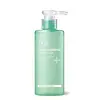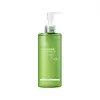What's inside
What's inside
 Key Ingredients
Key Ingredients

No key ingredients
 Benefits
Benefits

 Concerns
Concerns

 Ingredients Side-by-side
Ingredients Side-by-side

Water
Skin ConditioningPotassium Laureth Phosphate
EmulsifyingGlycerin
HumectantPotassium Cocoyl Glutamate
Acrylates/C10-30 Alkyl Acrylate Crosspolymer
Emulsion StabilisingButylene Glycol
HumectantAspartic Acid
MaskingSodium Cocoyl Glutamate
CleansingLauryl Hydroxysultaine
CleansingCoco-Glucoside
CleansingCaprylyl Glycol
EmollientGlyceryl Caprylate
EmollientPolyglyceryl-10 Laurate
Skin ConditioningCitrus Aurantium Dulcis Peel Oil
MaskingPolyglyceryl-10 Myristate
Skin ConditioningLavandula Angustifolia Oil
MaskingSodium Cocoyl Isethionate
CleansingDisodium EDTA
1,2-Hexanediol
Skin ConditioningQuillaja Saponaria Bark Extract
CleansingBifida Ferment Lysate
Skin ConditioningLactobacillus
Skin ConditioningLeuconostoc/Radish Root Ferment Filtrate
AntimicrobialMaltodextrin
AbsorbentMoringa Oleifera Seed Extract
Skin ConditioningOlea Europaea Oil Unsaponifiables
Skin ConditioningGlycine Soja Oil Unsaponifiables
EmollientTriticum Vulgare Germ Oil Unsaponifiables
EmollientPollen Extract
EmollientTheanine
EmollientMilk Lipids
Skin ConditioningGlutathione
Water, Potassium Laureth Phosphate, Glycerin, Potassium Cocoyl Glutamate, Acrylates/C10-30 Alkyl Acrylate Crosspolymer, Butylene Glycol, Aspartic Acid, Sodium Cocoyl Glutamate, Lauryl Hydroxysultaine, Coco-Glucoside, Caprylyl Glycol, Glyceryl Caprylate, Polyglyceryl-10 Laurate, Citrus Aurantium Dulcis Peel Oil, Polyglyceryl-10 Myristate, Lavandula Angustifolia Oil, Sodium Cocoyl Isethionate, Disodium EDTA, 1,2-Hexanediol, Quillaja Saponaria Bark Extract, Bifida Ferment Lysate, Lactobacillus, Leuconostoc/Radish Root Ferment Filtrate, Maltodextrin, Moringa Oleifera Seed Extract, Olea Europaea Oil Unsaponifiables, Glycine Soja Oil Unsaponifiables, Triticum Vulgare Germ Oil Unsaponifiables, Pollen Extract, Theanine, Milk Lipids, Glutathione
Vitis Vinifera Seed Oil
EmollientCaprylic/Capric Triglyceride
MaskingSorbeth-30 Tetraoleate
EmulsifyingBrassica Campestris Seed Oil
Skin ConditioningCamellia Sinensis Seed Oil
HumectantMacadamia Ternifolia Seed Oil
EmollientTocopherol
AntioxidantWater
Skin ConditioningButylene Glycol
HumectantLeuconostoc/Radish Root Ferment Filtrate
AntimicrobialGlycerin
HumectantQuillaja Saponaria Bark Extract
CleansingSaponaria Officinalis Leaf Extract
Antimicrobial1,2-Hexanediol
Skin ConditioningLactobacillus
Skin ConditioningSalix Alba Bark Extract
AstringentBifida Ferment Lysate
Skin ConditioningParfum
MaskingVitis Vinifera Seed Oil, Caprylic/Capric Triglyceride, Sorbeth-30 Tetraoleate, Brassica Campestris Seed Oil, Camellia Sinensis Seed Oil, Macadamia Ternifolia Seed Oil, Tocopherol, Water, Butylene Glycol, Leuconostoc/Radish Root Ferment Filtrate, Glycerin, Quillaja Saponaria Bark Extract, Saponaria Officinalis Leaf Extract, 1,2-Hexanediol, Lactobacillus, Salix Alba Bark Extract, Bifida Ferment Lysate, Parfum
 Reviews
Reviews

Ingredients Explained
These ingredients are found in both products.
Ingredients higher up in an ingredient list are typically present in a larger amount.
1,2-Hexanediol is a synthetic liquid and another multi-functional powerhouse.
It is a:
- Humectant, drawing moisture into the skin
- Emollient, helping to soften skin
- Solvent, dispersing and stabilizing formulas
- Preservative booster, enhancing the antimicrobial activity of other preservatives
Bifida Ferment Lysate is derived from the fermentation of Bifida bacteria (often with dairy). It is a probiotic and helps to strengthen our skin's microbiome.
Having a healthy microbiome helps protect our skin against infection. It also helps our skin stay hydrated and healthy.
Studies also show this ingredient to be a promising soothing ingredient for sensitive skin.
Learn more about Bifida Ferment LysateButylene Glycol (or BG) is used within cosmetic products for a few different reasons:
Overall, Butylene Glycol is a safe and well-rounded ingredient that works well with other ingredients.
Though this ingredient works well with most skin types, some people with sensitive skin may experience a reaction such as allergic rashes, closed comedones, or itchiness.
Learn more about Butylene GlycolGlycerin is already naturally found in your skin. It helps moisturize and protect your skin.
A study from 2016 found glycerin to be more effective as a humectant than AHAs and hyaluronic acid.
As a humectant, it helps the skin stay hydrated by pulling moisture to your skin. The low molecular weight of glycerin allows it to pull moisture into the deeper layers of your skin.
Hydrated skin improves your skin barrier; Your skin barrier helps protect against irritants and bacteria.
Glycerin has also been found to have antimicrobial and antiviral properties. Due to these properties, glycerin is often used in wound and burn treatments.
In cosmetics, glycerin is usually derived from plants such as soybean or palm. However, it can also be sourced from animals, such as tallow or animal fat.
This ingredient is organic, colorless, odorless, and non-toxic.
Glycerin is the name for this ingredient in American English. British English uses Glycerol/Glycerine.
Learn more about GlycerinLactobacillus is a type of bacteria with skin conditioning properties. This ingredient has antibacterial and antifungal properties (that's why we can eat fermented foods).
Learn more about the benefits of lactobacillus ferment here.
Fun Fact: Lactobacillus is used to create wine, yogurt, cheese, sauerkraut, pickles, beer, cider, kimchi, cocoa, kefir.
Learn more about LactobacillusLeuconostoc/Radish Root Ferment Filtrate is a natural preservative. It comes from fermenting radish roots with a bacteria called leuconostoc.
Leuconostoc comes from lactic acid.
This ingredient has antimicrobial properties and helps prevent the growth of bacteria in a product.
Leuconostoc is used to make the traditional Korean side-dish, kimchi. It is also used to make sourdough bread (both incredibly yummy foods).
Learn more about Leuconostoc/Radish Root Ferment FiltrateWe don't have a description for Quillaja Saponaria Bark Extract yet.
Water. It's the most common cosmetic ingredient of all. You'll usually see it at the top of ingredient lists, meaning that it makes up the largest part of the product.
So why is it so popular? Water most often acts as a solvent - this means that it helps dissolve other ingredients into the formulation.
You'll also recognize water as that liquid we all need to stay alive. If you see this, drink a glass of water. Stay hydrated!
Learn more about Water